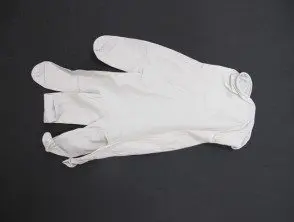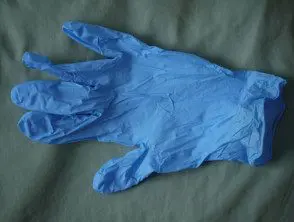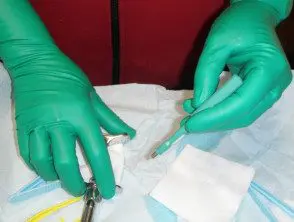What is contact? dermatitis?
Contact dermatitis is a eczematous Skin reaction derived from direct contact with a causative agent. It is the most common type of occupational skin disease. Contact dermatitis is classified as allergic contact dermatitis or irritating contact dermatitis or a combination of both.
Nitrile contact dermatitis is primarily allergic contact dermatitis, but irritant contact dermatitis can also occur.
What is nitrile and what is it used for?
Nitrile is an organic compound most commonly used to produce nitrile rubber. Nitrile rubber is a large synthetic rubber, a copolymer of acrylonitrile and butadiene, used in the production of latex-free gloves. Nitrile rubber is also used to produce drive belts, seals, and hoses.
Nitrile is also used in the production of insecticides and as a raw material for the production of synthetic fibers and resins. [1].
Nitrile Gloves

Nitrile Exam Gloves

Blue nitrile glove

Green gloves in surgery
Who gets nitrile contact dermatitis?
Allergic contact dermatitis to nitrile is more likely in people who wear disposable nitrile rubber gloves.
- They have often chosen latex-free nitrile gloves because they also have latex. allergy.
- The most commonly affected professions include healthcare workers (dentists, nurses, doctors), hairdressers, and food handlers.
- Contact dermatitis can rarely affect people who work in the automotive and aircraft industries or in industrial factories that produce synthetic fibers or insecticides.
Irritant contact dermatitis associated with the use of nitrile gloves may be due to atopic dermatitis, dry skin, occlusionsweating repetitive washing or friction, among other causes.
What Causes Nitrile Contact Dermatitis?
Nitrile allergic contact dermatitis is usually due to an allergy to the rubber accelerators used to make nitrile rubber gloves. [2]. These include thiurams, dithiocarbamates, and mercaptobenzothiazole [3].
Hypersensitivity It can also be due to acrylonitrile, but this is extremely rare. Acrylonitrile is a small molecule that can easily penetrate the skin and has been recognized as a powerful toxin and sensitizer [1,4,5].
What are the clinical features of nitrile contact dermatitis?
Allergic contact dermatitis is a delayed-type hypersensitivity reaction.
- It comes as a pruritus, erythematous, scaly eruption in the areas of contact with the skin.
- Allergic contact dermatitis can spread to distant sites.
-
Irritant contact dermatitis is generally limited to the site of contact.
- Transient paresthesias have also been reported and are believed to be due to acrylonitrile. See Cutaneous dysesthesia.
How is nitrile contact dermatitis diagnosed?
Allergic contact dermatitis is often diagnosed after taking a detailed medical history and carefully examining the patient.
Patch the test must include the location base Rubber series and accelerators.
Positive patch tests for nitrile

1+ positive patch test for nitrile

2+ positive patch test for nitrile
What is the treatment for nitrile contact dermatitis?
Treatment of contact dermatitis involves avoiding exposure to nitrile and current medical treatment.
Avoid exposure
Avoiding exposure to rubber accelerators requires the use of disposable gloves without a nitrile accelerator, such as Ansell Micro-Touch Nitrafree®, Showa N-dex free®, and Sensicare Free Accelerator Free Blue Nitrile Gloves®.
Inform dentists or doctors of any allergies to nitrile gloves, although exposure in the healthcare environment rarely causes problems.
In the rare case of an acrylonitrile allergy, butyl rubber gloves have been found to limit your permeability and it can be considered as an alternative for mechanics and factory workers [4,5]. These gloves are generally not practicable for healthcare workers, hairdressers, or laboratory technicians.
Barrier creams have not been found to protect sufficiently against acrylonitrile penetration and are not recommended [4].
Medical treatment
At acute phase, treatment is as for any acute dermatitis or eczema including the use of a soap substitute, moisturizer creamand topical corticosteroids.
What is the result of nitrile contact dermatitis?
the forecast after the diagnosis of nitrile contact dermatitis is dependent on patient education and avoidance of allergen. Approximately 10 to 15% of people with occupational contact dermatitis continue to experience dermatitis [6].

